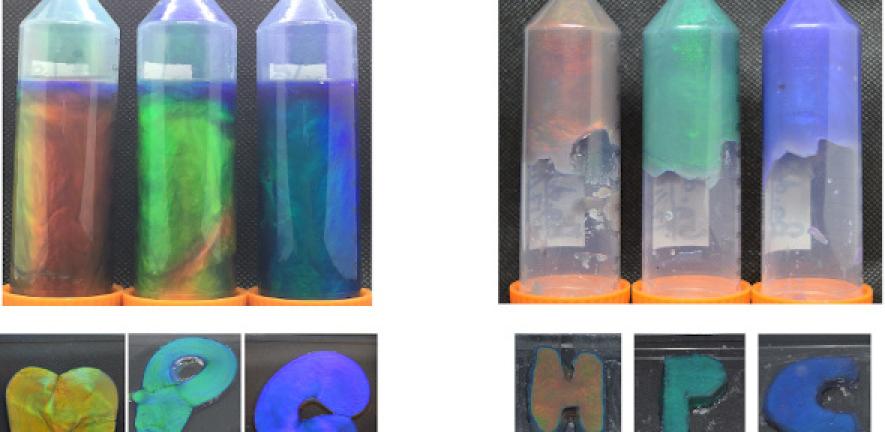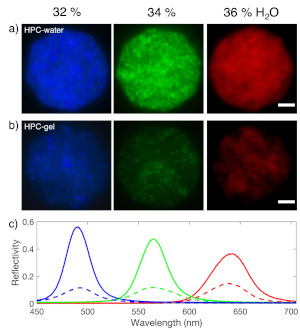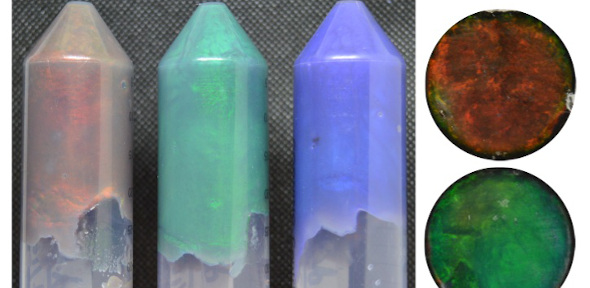
In a paper published in Advanced Materials, the researchers demonstrate how hydroxypropyl cellulose (HPC) can be mixed with gelatine and water in a scalable fashion to create a material that changes colour in response to certain stimuli, making it ideal as a sensor, especially where biocompatibility and/or cost are key considerations.
HPC is a highly viscous, biodegradable cellulose derivative used widely in the medical and other industries, for example as an eye treatment and as a thickener and stabiliser in various foods. Interestingly, HPC can form structural colour, which is colour achieved through its inherent structure rather than through any external pigments or dyes. This is termed photonic HPC.
Although extensive studies have been conducted on photonic HPC, the development of cellulose applications has been slow, most likely due to the prevalence of plastic alternatives. However, as environmental concerns become more widespread the search for more eco-friendly materials has become increasingly urgent, with potential applications for bio-compatible cellulose derivatives again receiving attention.
 Lead author PhD student Charlie Barty-King
Lead author PhD student Charlie Barty-King
“My goal is to take HPC and find applications for it that can easily be scaled up,” explains Charlie Barty-King, a PhD student here and the paper’s lead author. “Chemistry is good at finding amazing new materials but they often cost too much or are difficult to handle -- we’re focused on the opposite of that – we want to find economic and scalable materials that can begin to compete with plastics.”
To do this, Charlie and colleagues in the Bio-inspired Photonics group and the Institute for Manufacturing (IfM) mixed HPC with gelatine and water, all of which are widely available, to create a gelled material that is mouldable as a continuous, unsupported solid. “Before, if people wanted to capture the photonic HPC state, which is a liquid, they needed an external architecture,” he explains, “but here we’ve actually added an internal architecture, so it’s a solid gelatine network with pockets of HPC within it which can still flow, providing a dynamic colouration yet solid material.”
One advantage of the gel is that it maintains the liquid HPC’s vibrant colouration as well as its ability to change colour in response to pressure, known as mechanochromism. “Other researchers have devised ways of capturing the photonic HPC state into a solid, but without retaining its ability to change colour,” says Charlie.
 In fact, the new cellulose gel’s mechanochromism is enhanced in two ways: First, because the gelatine gives elasticity to the material, the gel has a quicker mechanochromic relaxation time, which is the time the material takes to return to its original colour after the pressure is relaxed. Second, this same elastic quality means a greater pressure is needed to achieve a colour change. So a sensor made from this gel would be able to respond at greater frequencies and have a broader working range than a sensor which uses liquid HPC, with a final advantage that it can be moulded as a solid.
In fact, the new cellulose gel’s mechanochromism is enhanced in two ways: First, because the gelatine gives elasticity to the material, the gel has a quicker mechanochromic relaxation time, which is the time the material takes to return to its original colour after the pressure is relaxed. Second, this same elastic quality means a greater pressure is needed to achieve a colour change. So a sensor made from this gel would be able to respond at greater frequencies and have a broader working range than a sensor which uses liquid HPC, with a final advantage that it can be moulded as a solid.
The new hydrogels have potential applications as short-term sensors in, for example, biodegradable “smart labels” for food packaging. “A sensor made with this material gives you a simple visual indicator and is easy to understand. All you need to know is if the sensor changes to a particular colour, then it’s bad – you don’t need a range of electric sensors and the training to understand them, and they can be made to work with any common colour camera technology, like smart phones.” This, and the low cost of the hydrogels, makes them especially useful in underdeveloped parts of the world, as well as medical uses where quick and correct identification is imperative. Because they are also edible, the hydrogels could be used as additive-free novelty food colorants and decorations.
Charlie completed a Masters of Research in the Bio-inspired Photonics group of corresponding author Professor Silvia Vignolini as part of Cambridge’s Ultra Precision Engineering CDT, before moving on to PhD research. He is now based in co-author Professor Michaël De Volder’s Nanomanufacturing research group at the IfM, but is co-supervised by Professor Vignolini and has continued to collaborate with her group. His background in materials science, formulation chemistry, and the science of mixing and scaling has proved to be ideal for this research.
“Chemistry is often about finding novel chemicals, synthesis and materials – but sometimes less thought can be given to their practical application and how to do these things at scale,” says Charlie. “My work with Professor De Volder is on nanomanufacturing with a focus on being feasibly scalable, so my PhD is on combining those two ideas of producing new, sustainable materials in an economic and scalable way.”
With scalability in mind, Charlie introduced the use of a Planetary Centrifugal Mixer, a type of industrial mixer which not only allows greater consistency of results but also greatly reduces preparation time. “We also went pretty much exclusively for gelatine because besides being edible it’s so industrially well-known and scalable,” he explains. Although this research used gelatine derived from pork, Charlie points out that vegan alternatives such as xanthan gum or carrageenan could also possibly be used.
Charlie is also keenly aware that cellulose is a sustainable, biodegradable material that won’t pollute the environment. As a member of Wolfson College, he founded its Green Society and helped launch and drive the College’s Sustainability and Conservation Interdisciplinary Research Hub. He holds an NUS Green Impact Challenge Student Leadership Award and was a recipient of the Vice-Chancellor’s Social Impact Award 2021 for his activities. He says: “One of the main reasons I’ve focused on cellulose and HPC materials, is to show that they are a viable alternative to petrochemical plastics. The problem with plastics is that they are so useful – but there are a lot of applications where you do not really need plastic, and could use an alternative.”

Research
Mechanochromic, Structurally Colored, and Edible Hydrogels Prepared from Hydroxypropyl Cellulose and Gelatin, Charles H. Barty-King, Chun Lam Clement Chan, Richard M. Parker, Mélanie M. Bay, Roberto Vadrucci, Michael De Volder, and Silvia Vignolini, Adv. Mater. (2021).

